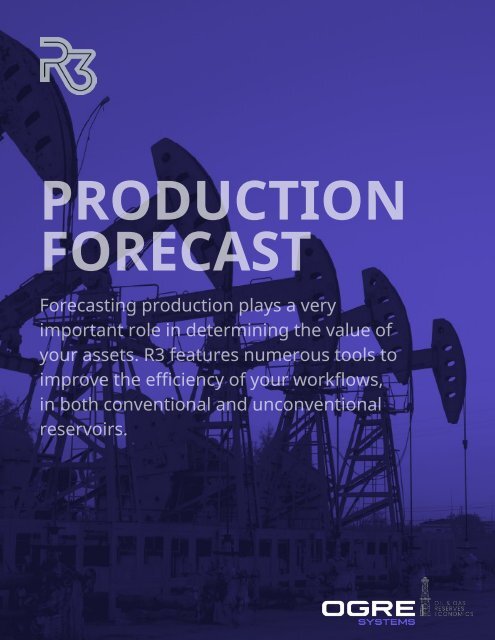GUIDE TO PRODUCTION FORECAST IN R3
- No tags were found...
Create successful ePaper yourself
Turn your PDF publications into a flip-book with our unique Google optimized e-Paper software.
<strong>PRODUCTION</strong><br />
<strong>FORECAST</strong><br />
Forecasting production plays a very<br />
important role in determining the value of<br />
your assets. <strong>R3</strong> features numerous tools to<br />
improve the efficiency of your workflows,<br />
in both conventional and unconventional<br />
reservoirs.
DECL<strong>IN</strong>E CURVE<br />
ANALYSIS<br />
Decline curve analysis is a traditional means of predicting well<br />
performance and well life, based on real production data.<br />
<strong>R3</strong> Graphics features the many necessary functions required to do quality<br />
decline curve analysis on assets. Various templates are available,<br />
including rate vs time and rate vs cum. There are five standard curve<br />
types that can be fit to historical data - linear, hyperbolic, exponential,<br />
harmonic and flat. Forecasts can be created with multiple segments.<br />
Walk mode allows the user to traverse up and down a fit to get details at<br />
any point in time, while the production data table gives monthly data of<br />
the fit in tabular form. Numerous culling options are available, making it<br />
very easy to include or exclude data.
ANALOGUE<br />
TABLE<br />
The analog table is a component which<br />
stores the parameters for decline<br />
curves. Each phase is shown, including<br />
any defined ratios, and each curve<br />
segment has its own line.<br />
Multi-segment forecasts can be handled<br />
as consecutive or overlapping. If you<br />
have a fully defined segment and you<br />
add an additional segment, then the<br />
starting date and rate values of the new<br />
segment are tied to the ending values<br />
of the prior segment.<br />
Or you can manually input the values for each segment, and<br />
stagger the starting dates as little or as much as you wish. The<br />
program will automatically calculate the undefined parameters<br />
for a forecast segment, after a user inputs enough parameters.<br />
ARCHIVE<br />
<strong>FORECAST</strong>S<br />
Comparing forecasts from year to year is<br />
often part of the workflow for engineers. <strong>R3</strong><br />
can store prior forecasts as Archives, making<br />
it easy to reapply them, and compare them<br />
on a graph with current forecasts. The<br />
Archive includes the data used in the fit so<br />
you can see why the fits may differ from each<br />
other. You can modify Archives to be shown<br />
in different colors for easy tracking.
TYPE WELL<br />
PROFILES<br />
Engineers often find the need to generate Type Well Profiles from a group of<br />
analogous wells to represent the forecasted behavior of new wells in a development.<br />
<strong>R3</strong> makes this really easy to do. Production profiles of one phase, with the option to<br />
include forecasts, are normalized to first month of production. Data can be culled<br />
and assets can be made active/inactive, until you have a representative data set of<br />
your area. The provided QC Chart helps with this process, by showing the ratio of the<br />
P10/P90 values for each month of data. Any values greater than 10 on this chart<br />
represent a data set with a wide range of values, indicating wells that may not be<br />
similar enough to group together. The Data Tab shows all data, including culled<br />
points.<br />
The Type Well Profiles can be generated using the Normal Distribution Method, or<br />
the Empirical Distribution Method. The program generates data points for various<br />
statistics of the data set – Mean, Max, Min, Mode, P10, P50, and P90. Using <strong>R3</strong><br />
Graphics, the user fits curves to some or all of these statistics, and saves the file.<br />
The steps are easy to repeat for any additional phases, or groups of wells. Once a<br />
TWP file is saved, it can be called up in Asset Manager, and any of the fits, IE P10, can<br />
be applied as a forecast to an asset. This can be done manually, with our Well<br />
Schedule tool, or within the Query Action Tool.
UNCONVENTIONAL<br />
<strong>FORECAST</strong><strong>IN</strong>G<br />
<strong>R3</strong> has several featured curve types to assist with forecasting unconventional resources.<br />
First, a multi-segment forecast curve where a hyperbolic forecast switches to an<br />
exponential forecast at a desired decline rate, for wells that experience multiple flow<br />
regimes. Another curve offered is a Stretched Exponential Decline Curve, which is a<br />
variation on traditional Arps that is better suited for unconventional reservoirs. (This<br />
method always gives a finite EUR value, even if no abandonment constraints are used). A<br />
third special curve type is the Duong Method curve, for use with reservoirs with low<br />
permeability and long periods of transient flow.
GAS RESERVOIR EUR<br />
<strong>FORECAST</strong><strong>IN</strong>G<br />
<strong>R3</strong> offers tools to help you estimate the Expected Ultimate Recovery (EUR) for gas<br />
reservoirs, using material balance methods. There are P/Z vs Cum. Gas templates, with<br />
the ability to specify if you have a closed reservoir, an abnormal/high pressure reservoir,<br />
or a water-drive reservoir.



